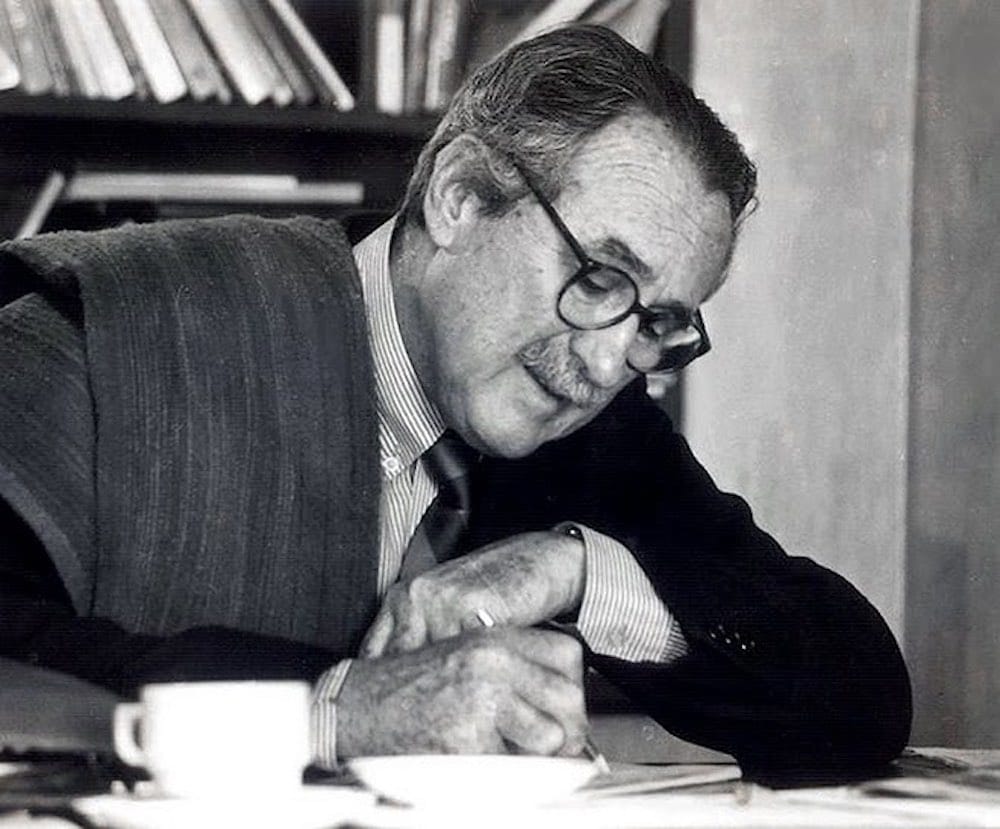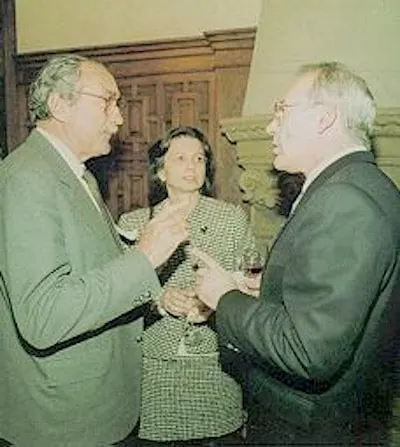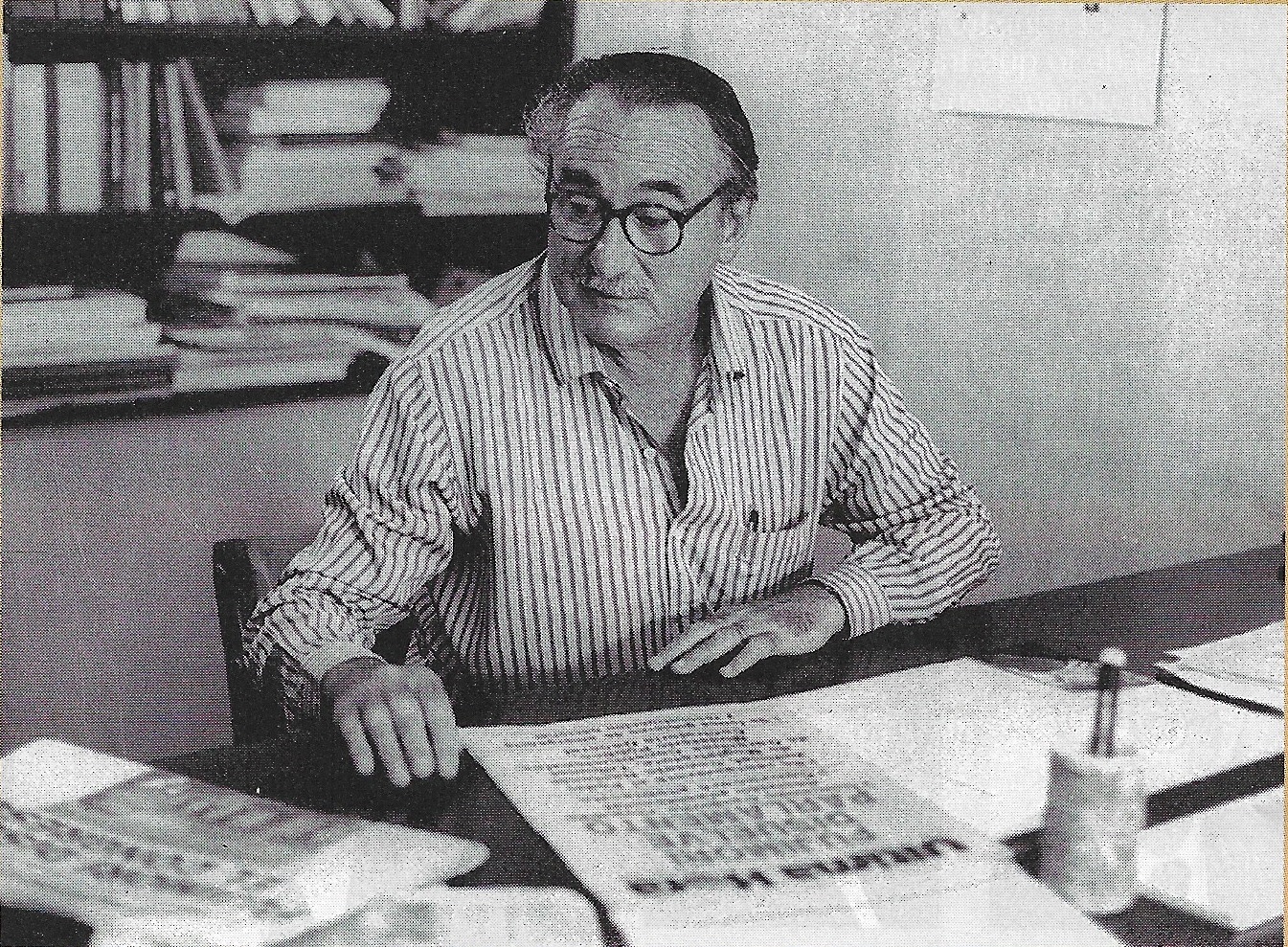This article about Igartua was first published on the website of the Limako Arantzazu Euzko Etxea and is the product of a collaboration between the Limako Arantzazu Euzko Etxea, Oiga magazine, and the Euskadi Munduan Association, which is responsible for the aboutbasquecounty.eus blog.
Exactly 100 years ago, on September 5, 1923, Francisco “Paco” Igartua was born, and we believe this event is worth celebrating.
The importance of the life and career of this Basque-Peruvian, both in the Basque Country and in Peru, leads us to choose his defense of and work for the Basque diaspora as our contribution to this year’s Day of the Basque Diaspora (on September 8).
His life is of special interest in a celebration such as this. He was born to a Basque father and a Catalan mother, and was aware of his “Basqueness” and his connection to his father’s homeland only as an adult. From that point on, his commitment to the Basque Country and to the Basque community in Peru was constant. Furthermore to this is his reach and prestige as a journalist in Peru, where he is an indisputable role model.
If we join together all these factors, it’s easy to see why we’re convinced Francisco “Paco” Igartua is a significant figure in the 20th-century history of the Basque Country who deserves to be known and recognized by his Basque compatriots, inside and outside Peru.
Biography of Francisco “Paco” Igartua


On September 5, 1923, journalist Francisco “Paco” Igartua Rovira was born in Huarochirí, just outside Lima, Peru. He was the founder of two of the leading political magazines in Peru, Oiga and Caretas. At the same time, quite passionately, he wrote not only informative articles but also opinion ones, positioning himself against corruption and in defense of democracy, social justice, and the freedom of the press, which caused him persecution and even exile throughout his life.
In the 1940s, he began his career at the weekly Jornada, which he quit because they would not let him publish his account of the beating he received when he tried to interview Víctor Raúl Haya de la Torre, the founder and most important leader of the Peruvian Aprista Party.
In 1948, he founded Oiga magazine, which had an eventful existence. In its first era, only four issues managed to get published because the General Manuel Odría regime ordered its closure, sending Igartua to prison, and then to exile in Panama.


During his exile, he attended a writers’ conference held in Chile. There, with the help of Curcio Malaparte and Camilo José Cela, he made a request to the Peruvian government to return to his country. In the meantime, the two authors accompanied him to Lima and he took refuge at the newspaper El Comercio, until the government authorized his return and ended his exile.
After his return to Peru, in 1950, alongside Doris Gibson, he founded the magazine Caretas, which is still the leading political journal in Peru. After many years, in 1963, he re-opened Oiga. This new era ended in 1974, when the military dictatorship of General Juan Velasco closed the magazine and persecuted its director, who took refuge in Mexico.
He lived there for four years, working as the director of the cultural supplement for the Mexican daily El Sol. The Basques of the diaspora helped him greatly.
In 1978, he once again returned to Peru and re-re-opened Oiga, where he continued reporting on the excesses of the members of the political and upper classes of his country.


It was the then-current dictator, Alberto Fujimori, who finally sentenced Oiga magazine to death, given the magazine’s editorial line that was always fighting against fujimorismo. To force its closure, the regime turned to the tried and true method of overwhelming tax burdens. Oiga finally closed in 1995.
The “heritage” of this journal, that is to say its archives, trademarks, and masthead, are now in the hands of Editorial Periodística Oiga, whose goal is to preserve the integrity of the memory and the principles that guided its founder and director for almost 50 years.
Paco Igartua continued writing for several Peruvian newspapers, such as Correo and Expreso. He would continue making himself heard in his “Canta Claro” pieces, where he covered economic, political, and social matters.
In addition to this fruitful journalistic activity, he published several books, including Siempre un extraño, the first part of his memoirs, and Reflexiones entre molinos de viento, a collection of his articles.
He was married to Clementina Bryce, the sister of famous Peruvian author Alfredo Bryce Echenique, and had two children.
He passed away in Lima on March 24, 2004.
A “Baskonia Americana” program dedicated to Paco Igartua – ©ETB 2005
Paco Igartua’s Transformation into a Basque-Peruvian
But there is one facet of his personality and his being that is not well known in Peru, despite being key to his identity. We’re referring to his commitment to all things Basque, to his connection with his roots that stretch back to Oñati, at the heart of the Basque Country, very near where Our Lady of Aránzazu had her original basilica.
This last bit might seem portentous, as it was under the protection of Our Lady of Aránzazu that the Basques set up many guilds and brotherhoods throughout the Americas and the Philippines. These fraternities were where they gathered together and set up mutual aid societies. These bodies eventually created a network that tied together Basques all over the world, and they kept it active and working thanks to their support, for over two centuries. The first of these brotherhoods, the oldest, founded in 1612, was in Lima.
In his younger years, Igartua did not have a clear feeling that he belonged to a “Basque community.” His father died when he was very young, at the age of only eight, and his mother moved him and his siblings to Santiago, Chile, where Igartua spent his youth. He even spent a year in the Franciscan seminary there.
Curiously, the Franciscans are the order that is in charge of caring for the Sanctuary of Aránzazu and, apart from some exceptions, for the churches where the Basques located their guilds and brotherhoods in the Americas. In the case of Lima, where Paco Igartua carried out his whole personal and professional life, except for times of exile, the church where the Brotherhood of Our Lady of Aránzazu was constituted at St. Francis, and the chapel they bought and placed under the protection of Our Lady of Aránzazu is still there. Somehow, the “Peruvian Basqueness” was present in these details, even if he wasn’t aware of them yet.
In 1940, he returned to Lima to study Law at the Catholic University of Lima. He was 17, and as he himself explained in an interview for the website Euskonews in 2002, the “feeling of Basqueness was superficial.” He felt it as a “peculiarity.”
So, how did it come to pass that years later, he would define himself as a Basque-Peruvian?
It all began with a 1951 trip by his sister to Barcelona to visit their mother’s side of the family, the Roviras. Once in Barcelona, she found out that her uncle, her mother’s brother, Ramón, lived and worked in San Sebastian. She paid him a visit, and through him they recovered their connection to their father’s side of the family.
All this reconnected Igartua not only with his paternal family, but also with his Basque ancestry. He made his first visit to the Basque Country in 1951, and from then until his death, his visits were quite regular, up to twice a year, and on each occasion, he visited the family homestead. Some trips he made alone, others with his wife, and still others with friends who accompanied him from Peru.
Paco Igartua, a Basque-Peruvian
From that moment on, Paco began down a path to getting closer to and to better understanding the reality of the Basques, both in their native homeland and in their New World diaspora.
He decisively collaborated in the revitalization of the group that then existed in Lima to bring Basques together; he connected with Basque political, social, and economic institutions in order to learn about the reality of his homeland; and he established relations with leading members of the organized Basque communities throughout the Americas.
This led him to become one of the leaders of the Basque community abroad for Basque institutions. This is easy to see in how the Lehendakari, the president of the Basque Government himself, personally invited him to the first two World Congresses of Basque Communities Abroad, where he played a key role from the very start, as secretary and by providing important contributions to both.
At the first congress, held in 1995, he gave a speech analyzing the image of the Basque Country abroad. He also helped recover collective Basque history about the presence and organization of the Basques abroad, specifically in the Americas.

When presented with the idea that the first Basque Center in the Americas was founded in the 19th century in Uruguay, Igartua reminded all that the Basques then present that the first organization the Basques founded was two centuries older. Indeed, in 1612, Basques who came from Alava, Biscay, Gipuzkoa, and Navarre gathered together at St. Francis’ church in Lima, which was run by the Franciscan friars (an order which, as you’ll recall, was and is responsible for the Sanctuary of Aránzazu), in order to create the Illustrious Brotherhood of Our Lady of Aránzazu in Lima. This was the first in a series of Basque institutions that appeared throughout the New World colonies, and which ended up becoming a support network, collaborating to defend the interests of the Basques. Recalling this part of Basque history at that congress was essential to opening up lines of research that would have undoubtedly opened up on their own, though perhaps much later without his comments.
At the second congress, held in 1999, he presented for the assembly’s approval a preliminary statement about the violence the Basque Country was living through, and the efforts of Basque society to overcome it. The text he presented was the following:
“As peace is the hardest, and, at the same time, supreme desire of all peoples, the delegations present at this Second Congress of Basque Communities, with the serene perspective offered by distance, support Basque society, the Basque Government, and other Basque institutions in their determination to carry forward the peace process that has already begun and to which we are all committed.”
The assembly approved the statement unanimously.
His Vision of the Basque Reality in a Time of Crisis
But this role as a Basque-Peruvian, as he called himself, was also to be found in his work as a journalist in Peru. With his Oiga magazine closed, he wrote the “Canta Claro” section, and in a September 2002 article titled “Trying to Clarify the Basque Issue,” he sought to explain to other Peruvians what was happening in the Basque Country at a time when the propaganda machine of the Spanish Government, then headed by José María Aznar, tried (and in many cases succeeded) to internationally broadcast a biased and twisted view of what Basque society was like and what was occurring there.
TRYING TO CLARIFY THE BASQUE ISSUE
Francisco Igartua, September 2002
Lately, on the streets and at social affairs, I have run into many readers of this column who, in a curious coincidence, have asked me to write about a topic that neither the press nor television can seem to explain. “On the one hand,” one of them told me, “I see that the ETA is a splinter cell, and on the other I see many thousands of people supporting them on TV.” I will therefore try to grant those readers this wish, and in this brief article, clarify this great Basque issue.
To begin, I will clarify that the current situation in the Basque Country was created, for electoral reasons, by the leader of the Spanish right, who aspires to win the Spanish presidency by absolute majority. With several attacks against Basque nationalism (the latest has been making the Batasuna party illegal), Mr. Aznar praises Spanish nationalism (millions of votes) and places his enablers, the Socialists, in his political cabooses, forcing them to join in on the anti-Basque adventure, as it would not behoove them to make enemies of the supermajority electorate, in the whole peninsula. At the same time, these attacks have created internal tensions within Basque nationalism, which has its own electoral whims.
The latest provocation, making the Batasuna political party illegal thanks to a decision handed down by Judge Garzón, has placed the Basque police up against the Basque protesters, who, like the Basque Government, are against this decision, not because of sympathy for Batasuna, but rather because both sides believe that this is an attack on political freedom. Having an opinion, they say, is not a crime; nor is failing to condemn or to protest against the assassinations carried out by the ETA.
Moreover, this is also mainly because the Basque Government and the majority of Basques are sure that this measure will not weaken but rather strengthen the ETA criminal group.
And here the reader might wonder, bewildered, why is the Basque police, which is under the authority of the Basque autonomous government, repressing the marches in Bilbao and San Sebastian? Quite simply, it’s because Lehendakari Ibarretxe’s government is trapped by having to enforce the law. The decision seems to him an aberration, but the State’s Law forces Garzón’s decision to be followed. Standing up to the judge’s decision would lose the Basque Government ground in its leading argument with Madrid: demanding the full compliance of the Statutes of Guernica, which has yet to be fully put into practice because Madrid refuses to transfer all the powers the Statute says it should to the autonomous government.
In order to understand this mess, it is necessary, even if only superficially, to explain what Basque nationalism consists of. In a few words, I’ll say that it’s based on the conviction that the Basque Country, Euskal Herria, historically has an unmistakable national identity, whose future (which is not necessarily independence) must be decided upon freely by the Basques.
But Basque nationalism, like all things Basque, is coarse and individualistic, and there isn’t just one. There are four factions: the Basque Nationalist Party, Eusko Alkartasuna, Batasuna, and the ETA. The latter is not a political party but rather a criminal organization of a Marxist affiliation that uses nationalism for its communist aims. The first two, with personal frictions between them, have nothing to do with terrorism, and make up the autonomous government of the Basque Country, a moderate and highly efficient government that has made the Basque Country one of the most prosperous regions in Europe. Batasuna is a crazy socialist movement that also demands self-determination, but it does not condemn the ETA’s violence, and some of its members stir up an irrational hatred towards Spain.
This political maneuver by Aznar and Oreja, his advisor on the matter, has been to put all four of them into the same sack, thereby gaining the applause and votes of 90% of the peninsula, but stirring up great furor among the Basque youth, and strengthening the contacts the ETA has with the extremist elements in Batasuna. It could set the Basque Country on fire.
Against this absurd and anti-democratic fire is the PNV–EA government, accompanied by those who hope for peace in the Basque Country, including Basque bishops (to the scandal of Spanish bishops and the ire of Aznar, who fruitlessly tried to get the Vatican to condemn the Basque Church). This peace cannot be reached with the police but only with dialogue. And making Batasuna illegal only strengthens the ETA and cuts off a string to a possible negotiation; it is similar to what happened in Ireland with the IRA, thanks to the mediation of Sinn Fein.
The right-wing Aznar government has not wished to follow the advice of reason and good sense given to him by, among others, the former president of Italia Cossiga. He has preferred to blindly shout out the Franco-era saying: “One Spain, better Red than Broken!” Wouldn’t being a multiple enrich and fit better within 21st-century Europe?
Igartua, who was committed to the right of the Basques to decide their future and their right to achieve it via democratic means that were free of violence, closely followed, as you can see, the tense political and social situation the land of his forebears was going through.
His connection with his father’s homeland even led him to consider founding and directing a magazine in the Basque Country that would be similar to Oiga in Peru. This idea received the backing of some Basques in the diaspora, who considered supporting it financially. In the end, the idea never took shape due to his illness, in addition to the fact that keeping up will all the latest in the social, political, and economic reality of the Basque Country, to the level of detail needed by a magazine such as that, would be hard.
Igartua, a Lasting Legacy
Paco Igartua is, in his life and his work, a reflection of the best values that Basques are so proud of. He is a part of that small group of people who, thanks to their convictions, their commitment, and their ability to defend their beliefs without flagging or bending to the authorities’ will, have left an indelible mark on their countries. His commitment to freedom, social justice, and democracy, and his tireless fight against corruption and totalitarianism, cost him many sacrifices and persecutions in life, but they gave him the satisfaction of giving Peru and the Basque Country one of their most illustrious sons and eminent role models, because he believed his actions were just and he believed in what he was doing.
More information:
- Articles about Paco Igartua on aboutbasquecountry.eus
- «Paco» Igartua» on Wikipedia
- Interview with Paco Igartua on Euskonews (2002)
- Article by Palmira Oyanguren about Paco Igartua on Euskonews
- Article by John Bazan Aguilar about Paco Igartua on Euskonews
- “América y la identidad vasca” by Paco Igartua in Euskaletxeak magazine


Last Updated on Feb 12, 2024 by About Basque Country





























